 Winterfat, (Krascheninnikov lanata), also known as white sage, first came to the attention of North American botanists in plant materials collected by the expeditions of Lewis and Clark. Using this plant material, pioneer botanist Federick Pursh described the shrub as winterfat, Euratia lanata.
Winterfat, (Krascheninnikov lanata), also known as white sage, first came to the attention of North American botanists in plant materials collected by the expeditions of Lewis and Clark. Using this plant material, pioneer botanist Federick Pursh described the shrub as winterfat, Euratia lanata.
The first generation of range managers identified this species with the widely occurring and highly important species of the western range suitable for grazing and browsing. Federick Pursh did not realize that similar shrubs occurred in Eastern Europe and into central Asia. After an intermediate period of a scientific name change to Ceretoides lanata, winterfat was changed to Krascheninnikov lanata in honor of Russian botanist Stephen Krascheninnikov.
Winterfat is a member of the Chenopod or Goosefoot family that includes such landscape characterizing species as shadscale (Atriplex confertifolia), four-wing saltbush (Atriplex canescens), Bailey’s greasewood (Sarcobatus baileyi) and black greasewood (Sarcobatus vermiculatus). Many of these shrubs are sufficiently spiny to discourage browsing or even cause mechanical injury to browsing animals. Black greasewood is poisonous to ruminants, especially when browsed during early spring. Livestock on winter ranges obtain digestible protein by licking the seeds (fruits) of these species from the soil surface.
Winterfat is not only an important browse species to livestock, but also wildlife species such as bighorn sheep (Ovis canadensis), Rocky Mountain elk (Cervus canadensis), pronghorn antelope (Antilocapra americana) and desert tortoise (Gopherus agassizii).
The nutritional value of winterfat is rated as above average, with crude protein levels ranging from 14% during winter months to 21% during spring and early summer months.
Winterfat occurs in semi-arid to temperate regions of North America from Canada down to Mexico in many different plant communities. Although many salt desert species possess deterrents such as spiny assemblages, winterfat does not.
This silver-gray shrub is a component of a variety of salt desert plant communities in Nevada, including lake plains and alluvial fans where it often dominates extensive areas (Fig. 1) along with species such as bud sage (Artemisia spinescens), and needle-and-thread grass (Hesperostipa comata) or desert needlegrass (Achnatherum speciosum). On salt desert ranges in the Intermountain region of the United States, pioneer ranchers were astounded to observe cattle and sheep readily browsing on this native shrub and in fact recognized that cattle came off of winter ranges that possessed winter fat in excellent condition, therefor the name of this valuable shrub species was very fitting.
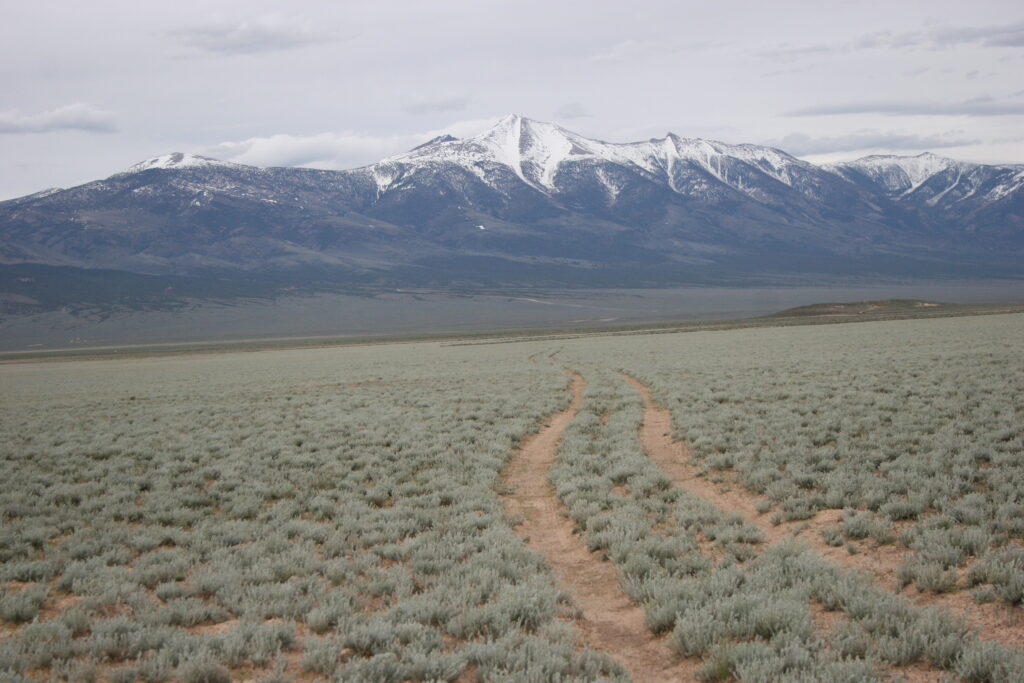
Figure 1. Winterfat stands provide excellent nutritional value,
especially during challenging winter months. Densities of winterfat vary
but can exhibit excellent dominant stands as seen here in Spring valley, Nevada.
In central and eastern Nevada, many winterfat communities are experiencing extensive die-offs and are being replaced by the exotic, invasive and noxious weed halogeton (Halogeton glomeratus) (Fig. 2).
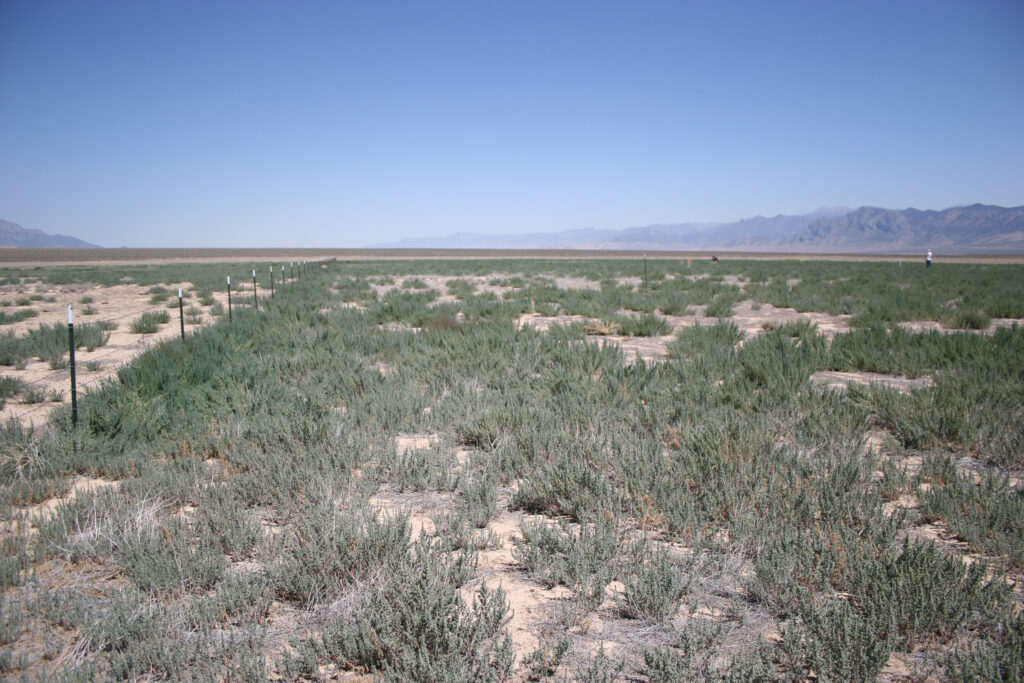
Figure 2. It is suspected that winterfat die-offs result in the invasion of Halogeton, as seen here. The establishment of desirable perennial grasses is one way to reduce halogeton densities, reduce salt concentrations on the soil surface, and move
Halogeton, also a member of the Chenopod family, is an annual weed that is poisonous to sheep. Most range scientists believe that halogeton is not killing winterfat, but rather moving into areas where winterfat has died out, although halogeton may compete with the recruitment of winterfat seedlings.
Halogeton accumulates salt in the plant tissue and is also leached from the roots back onto the soil surface, increasing soil salinity and pH levels which negatively affects the germination potential of many plant species, including winterfat.
Halogeton is also tough to perform effective weed control practices on due to the extensive longevity of this species to build persistent seed banks and for the seeds to acquire dormancy for a minimum of 10 years. We tested halogeton seed dormancy abilities for 10 years and still had seeds that were viable but dormant after 10 years, in which we quit testing.
Our initial approach was a combination of mechanical and chemical fallows followed up with plant material testing. We selected two sites in eastern Nevada, 1) Strawberry, just east of Eureka, Nevada and 2) Spring Valley, east of Ely, Nevada. Both sites already had a 10-acre exclosure to develop plots and conduct our research. Mechanical treatments consisted of disking plots in June to reduce halogeton densities followed by seeding with a half-sized rangeland drill the following late September. The chemical treatment consisted of applying 2,4-D at 2 lbs./acre rate in late July following halogeton emergence, fallowed and then seeded with a half-sized rangeland drill in late September. Our initial plant material testing consisted of 1) drill seed Indian ricegrass (Achnatherum hymnoides) @ 2 lbs./acre rate, 2) bottlebrush squirreltail (Elymus elymoides) @ 7 lbs./acre rate, 3) Siberian wheatgrass (Agropyron fragile) @ 7 lbs./acre rate, 4) ‘Hycrest’ crested wheatgrass (Agropyron cristatum) @ 7 lbs./acre rate and 5) broadcast seed winterfat @ 2 lbs./acre rate.
Initial seedling emergence of seeded species experienced higher seedling counts at the Spring Valley study site compared to the Strawberry Study site. For example, the best performing seeded species at the Strawberry site was crested wheatgrass, 0.13 plants/ft², and squirreltail, 0.10 plants/ft², compared to 0.28 plants/ft² with crested wheatgrass and 0.49 plants/ft² with squirreltail at the Spring Valley site. After 2 years of monitoring though, plant establishment of seeded perennial grasses significantly decreased with crested wheatgrass and squirreltail, declining down to less than 0.001/ft² for both species at both the Strawberry and Spring Valley sites.
The best performing seeded species, as far as established plants are concerned, occurred with Siberian wheatgrass, 0.28 and 0.36/ft² at the Strawberry and Spring Valley sites, respectfully. Broadcast seeding of winterfat experienced an initial emergence of 0.46/ft at Spring Valley and 0.01/ft² at Strawberry. There was no recorded establishment of winterfat after 2-years at the Strawberry site, whereas the Spring Valley site recorded an establishment rate of 0.02/ft². This extremely low establishment rate is far less than what is needed to restore and sustain healthy winterfat communities.
Moving forward, we adjusted our seeding efforts to focus on establishing Siberian wheatgrass to replace halogeton and reduce the issues halogeton has on salt accumulations on the soil surface as well as seeding salt tolerant species ‘Immigrant’ forage kochia (Bassia prostrata) and Russian wildrye (Psathyrostachys juncea) to provide additional sustainable forage.
We seeded Siberian wheatgrass @ 8 lbs./acre rate, Russian wildrye @ 10 lbs./acre rate, and ‘Immigrant’ forage kochia at 2 lbs./acre rate. We also increased the broadcast seeding rate of winterfat to 5 lbs./acre. Siberian wheatgrass experienced good emergence at both sites, 7.3 and 4.2/ft², respectfully.
Russian wildrye performed well at the Spring Valley site, 3.9/ft², but did poorly at the Strawberry site where only 0.02 plants/ft² were recorded. ‘Immigrant’ forage kochia recorded low initial emergence at Spring Valley, 0.003/ft², compared to 0.35/ft² at the Strawberry site. Winterfat continued to struggle even with the higher seeding rate, recording the establishment of less than 0.02 plants/ft².
After 2-years of monitoring, initial establishment was encouraging with Siberian wheatgrass recording the establishment of 2.1 and 1.8 plants/ft² at Spring Valley and Strawberry, respectfully. Russian wildrye recorded 0.8/ft² at the Spring Valley site (Fig. 3), but only 0.003/ft² at the Strawberry site. ‘Immigrant’ forage kochia did not record any established plants at the Spring Valley site, whereas at the Strawberry site ‘Immigrant’ forage kochia recorded the establishment of 0.35/ft² with excellent signs of newly sprouted seedlings (Fig. 4).
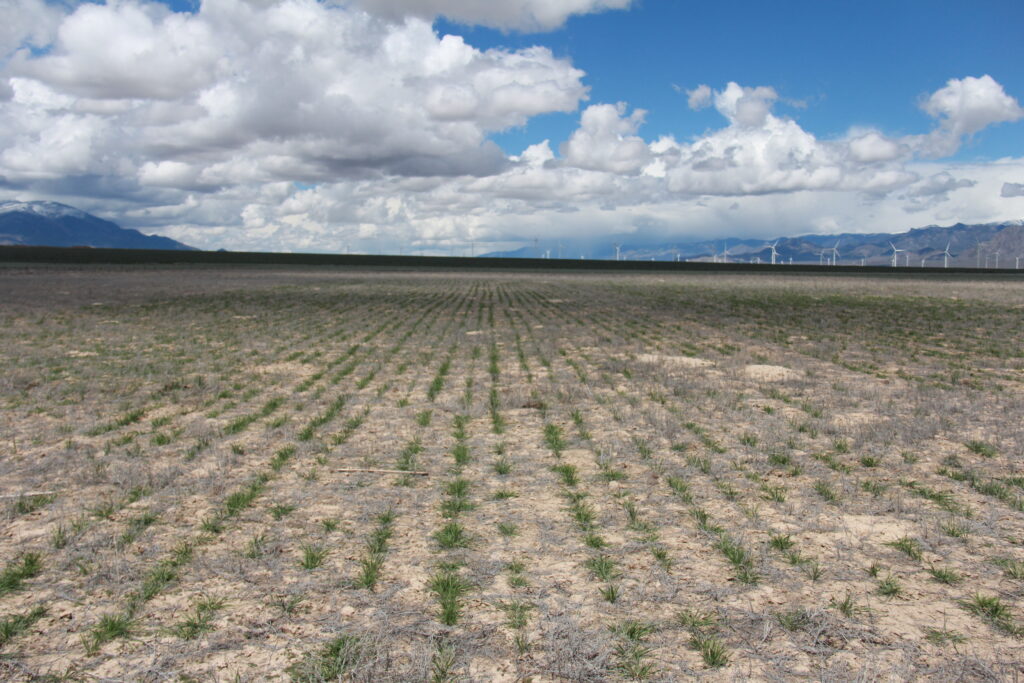
Figure 3 (above). Siberian wheatgrass has the inherent potential to germinate,
emerge and establish these arid environments, while replacing halogeton,
Russian thistle and other exotic weeds.
Figure 4 (below). Following plant material testing of numerous species, Russian wildryre stands out as a productive species to compete with exotic invasive weeds while also providing sustainable forage in these degraded winterfat communities.
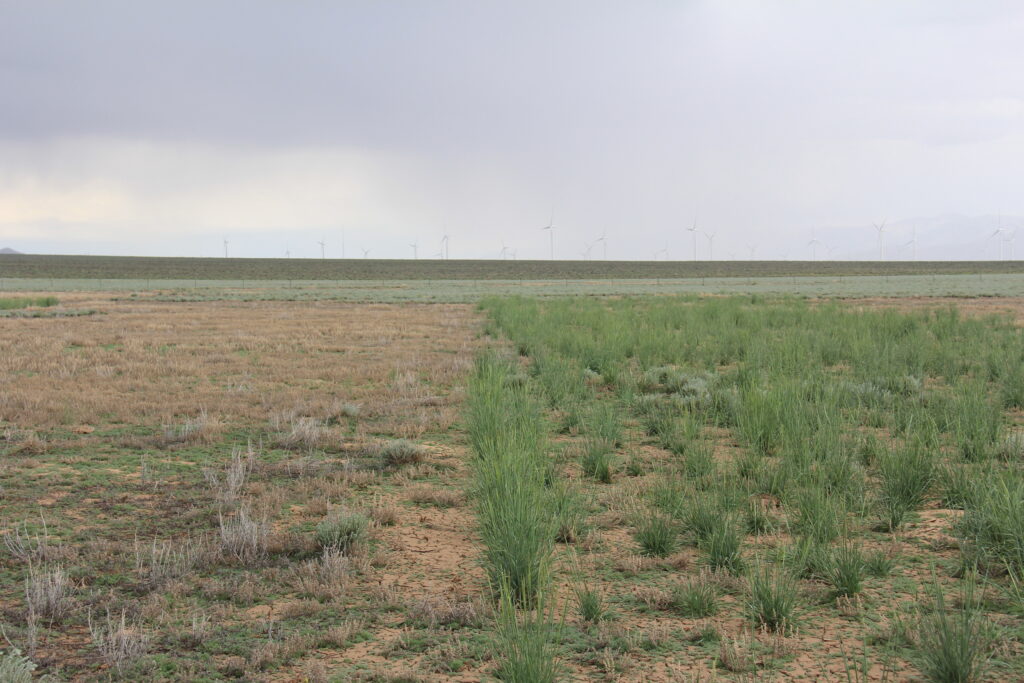
Anyone that has ever attempted to restore or revegetate rangelands understands how difficult it is to experience success over failure and the frustrations associated with this daunting task. These degraded winterfat communities are of no exception, yet we are encouraged by our experiences when looking back at others who have attempted the same daunting task.
The late range scientist, Perry Plummer, was one of the early pioneers in rangeland restoration, and he often reported on the wearisome difficulties in restoring winterfat communities. The fact that winterfat communities are primarily located on xeric, saline soils limits the potential for successful restoration or revegetation.
One of our major concerns is the fact that even though we experienced some level of initial emergence and establishment of Siberian wheatgrass and Russian wildrye, the ability of these species to persist on the sites grew increasingly challenging as stands declined within 5-years. ‘Immigrant’ forage kochia at the Strawberry site however, did persist and increased in density as the this species propagated very well within the seeded areas. It is important to note that winterfat communities are immensely variable, with significant differences in site potential due to soils and precipitation. The presence of competitive and exotic species often requires further intervention. To improve the probability of success, it is often essential to control competitive species such as halogeton, Russian thistle (Salsola tragus), and annual kochia (Kochia scoparia). Effective weed control of these species increases much needed soil moisture and nutrients for seedlings of seeded species. Because resources in these arid environments are limited, it is important to understand that heavy seeding rates may increase competition as seedling density may be more that the site can support.
Restoration or revegetation of winterfat communities is critical to support the sustainability of these grazing lands, wildlife, and the range livestock industry. It is important to recognize the challenges in attempting to restore or revegetate degraded rangelands in harsh environments. It is also important to recognize degradation early on; perhaps the threshold was passed in front of our very eyes and these belated restoration or revegetation practices would have been more successful if they had been attempted at an earlier stage of degradation. Our approach has been to experimentally investigate the challenges that resource managers are likely to endure when attempting to restore or revegetate degraded winterfat communities and to find ways to overcome these challenges.
By applying numerous approaches to small scale plots and learning from those experiments, we can better inform resource managers of challenges they will face, and hopefully they can learn from our efforts and avoid the costly failure of some of these restoration or revegetation efforts on thousands of acres of degraded winterfat communities.
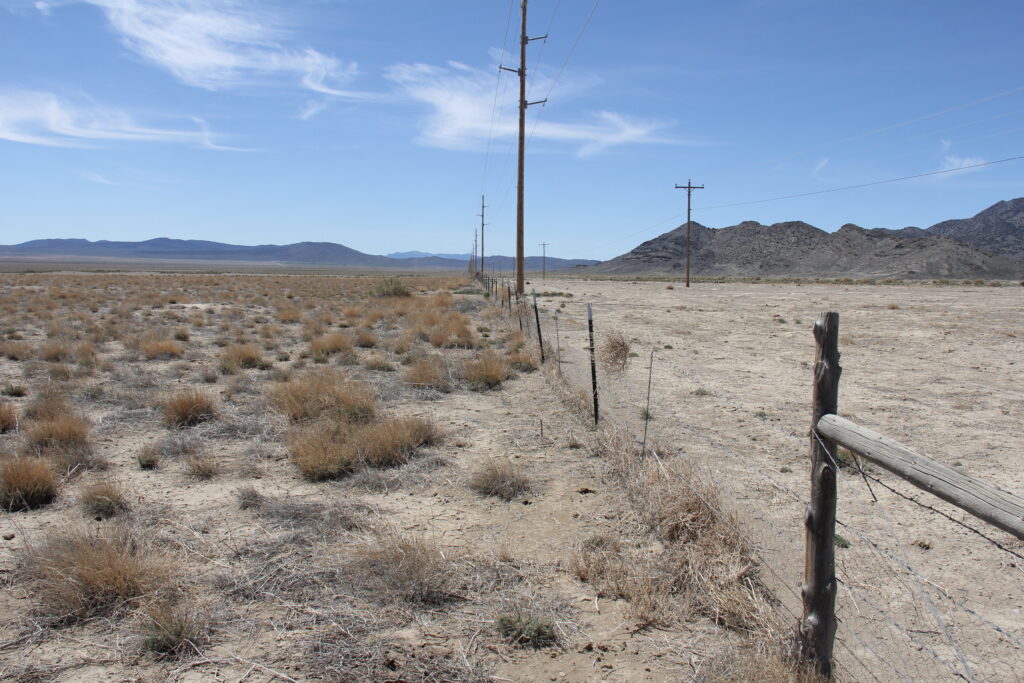
Figure 5. ‘Immigrant’ forage kochia has shown the ability to persist in arid environments with seedling recruitment levels that are needed for stand persistence.
By Charlie D. Clements and Dan N. Harmon
